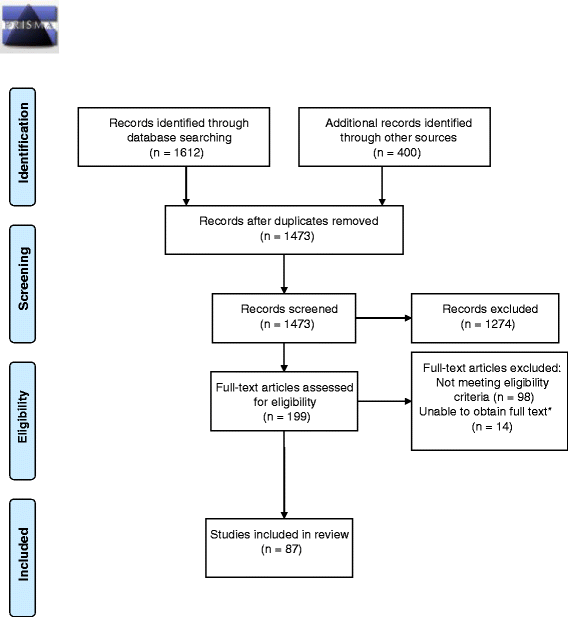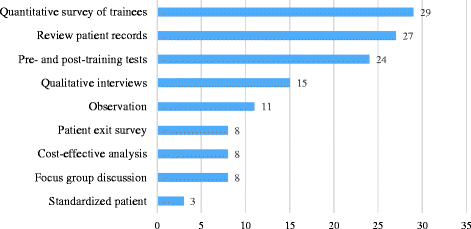Evaluations of training programs to improve human resource capacity for HIV, malaria, and TB control: a systematic scoping review of methods applied and outcomes assessed
- PMID: 28680324
- PMCID: PMC5493875
- DOI: 10.1186/s41182-017-0056-7
Evaluations of training programs to improve human resource capacity for HIV, malaria, and TB control: a systematic scoping review of methods applied and outcomes assessed
Abstract
Background: Owing to the global health workforce crisis, more funding has been invested in strengthening human resources for health, particularly for HIV, tuberculosis, and malaria control; however, little is known about how these investments in training are evaluated. This paper examines how frequently HIV, malaria, and TB healthcare provider training programs have been scientifically evaluated, synthesizes information on the methods and outcome indicators used, and identifies evidence gaps for future evaluations to address.
Methods: We conducted a systematic scoping review of publications evaluating postgraduate training programs, including in-service training programs, for HIV, tuberculosis, and malaria healthcare providers between 2000 and 2016. Using broad inclusion criteria, we searched three electronic databases and additional gray literature sources. After independent screening by two authors, data about the year, location, methodology, and outcomes assessed was extracted from eligible training program evaluation studies. Training outcomes evaluated were categorized into four levels (reaction, learning, behavior, and results) based on the Kirkpatrick model.
Findings: Of 1473 unique publications identified, 87 were eligible for inclusion in the analysis. The number of published articles increased after 2006, with most (n = 57, 66%) conducted in African countries. The majority of training evaluations (n = 44, 51%) were based on HIV with fewer studies focused on malaria (n = 28, 32%) and TB (n = 23, 26%) related training. We found that quantitative survey of trainees was the most commonly used evaluation method (n = 29, 33%) and the most commonly assessed outcomes were knowledge acquisition (learning) of trainees (n = 44, 51%) and organizational impacts of the training programs (38, 44%). Behavior change and trainees' reaction to the training were evaluated less frequently and using less robust methods; costs of training were also rarely assessed.
Conclusions: Our study found that a limited number of robust evaluations had been conducted since 2000, even though the number of training programs has increased over this period to address the human resource shortage for HIV, malaria, and TB control. Specifically, we identified a lack evaluation studies on TB- and malaria-related healthcare provider training and very few studies assessing behavior change of trainees or costs of training. Developing frameworks and standardized evaluation methods may facilitate strengthening of the evidence base to inform policies on and investments in training programs.
Keywords: Evaluation methods; HIV; Malaria; Scoping review; Training evaluation; Tuberculosis.
Figures
Similar articles
-
Beyond the black stump: rapid reviews of health research issues affecting regional, rural and remote Australia.Med J Aust. 2020 Dec;213 Suppl 11:S3-S32.e1. doi: 10.5694/mja2.50881. Med J Aust. 2020. PMID: 33314144
-
The effectiveness of internet-based e-learning on clinician behavior and patient outcomes: a systematic review protocol.JBI Database System Rev Implement Rep. 2015 Jan;13(1):52-64. doi: 10.11124/jbisrir-2015-1919. JBI Database System Rev Implement Rep. 2015. PMID: 26447007
-
School-based interventions for reducing disciplinary school exclusion: a systematic review.Campbell Syst Rev. 2018 Jan 9;14(1):i-216. doi: 10.4073/csr.2018.1. eCollection 2018. Campbell Syst Rev. 2018. PMID: 37131379 Free PMC article.
-
Public sector reforms and their impact on the level of corruption: A systematic review.Campbell Syst Rev. 2021 May 24;17(2):e1173. doi: 10.1002/cl2.1173. eCollection 2021 Jun. Campbell Syst Rev. 2021. PMID: 37131927 Free PMC article. Review.
-
Impact of summer programmes on the outcomes of disadvantaged or 'at risk' young people: A systematic review.Campbell Syst Rev. 2024 Jun 13;20(2):e1406. doi: 10.1002/cl2.1406. eCollection 2024 Jun. Campbell Syst Rev. 2024. PMID: 38873396 Free PMC article. Review.
Cited by
-
Evaluation of the Training Program to Train HIV Treatment Center Staff in Pakistan.Cureus. 2024 Jun 8;16(6):e61972. doi: 10.7759/cureus.61972. eCollection 2024 Jun. Cureus. 2024. PMID: 38855485 Free PMC article.
-
Assessing the impact of the TB response in Taiwan - the journey towards ending TB.IJTLD Open. 2025 May 12;2(5):251-259. doi: 10.5588/ijtldopen.25.0103. eCollection 2025 May. IJTLD Open. 2025. PMID: 40365028 Free PMC article.
-
Training for Tuberculosis Elimination in Indonesia: Achievements, Reflections, and Potential for Impact.Trop Med Infect Dis. 2019 Jul 18;4(3):107. doi: 10.3390/tropicalmed4030107. Trop Med Infect Dis. 2019. PMID: 31323840 Free PMC article.
-
The influence of quality of work life on motivation and retention of local government tuberculosis control programme supervisors in South-eastern Nigeria.PLoS One. 2019 Jul 24;14(7):e0220292. doi: 10.1371/journal.pone.0220292. eCollection 2019. PLoS One. 2019. PMID: 31339944 Free PMC article.
-
Strengthening health systems in Africa: a case study of the Kenya field epidemiology training program for local frontline health workers.Public Health Rev. 2017 Oct 24;38:23. doi: 10.1186/s40985-017-0070-7. eCollection 2017. Public Health Rev. 2017. PMID: 29450095 Free PMC article.
References
Publication types
LinkOut - more resources
Full Text Sources
Other Literature Sources


